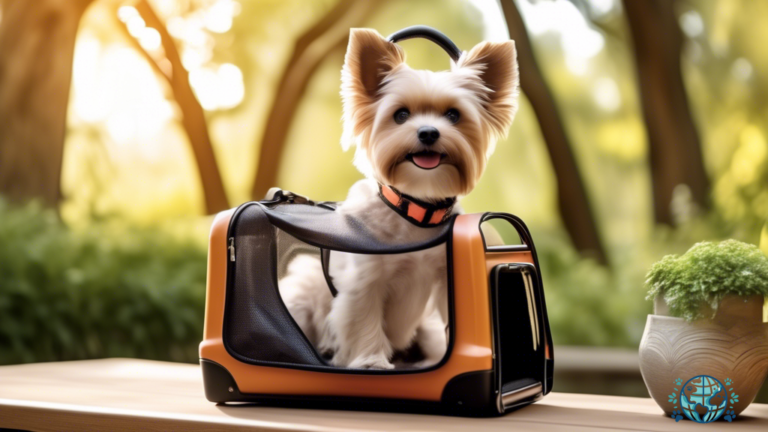Are you ready to embark on a journey with your furry, feathered, or even scaly companion by your side? Well, get ready to pack your bags and buckle up, because we’re about to dive into the wild world of traveling with emotional support animals!
Whether you’re planning a relaxing vacation or a business trip, having your trusty emotional support animal (ESA) by your side can make all the difference in the world. And hey, who said traveling can’t be a paw-some adventure?
Now, before we get too carried away with excitement, it’s important to understand the ins and outs of traveling with an ESA. In this guide, we’ll walk you through everything you need to know to ensure a smooth and stress-free journey for both you and your furry friend.
From qualifying for an emotional support animal to navigating airline policies and regulations, we’ve got you covered. So grab a leash, put on your adventure hat, and let’s embark on this journey together!
Key Takeaways
- Plan ahead and check airline policies to ensure compliance with regulations for traveling with emotional support animals.
- Take steps to ensure the comfort and well-being of the ESA during travel, such as providing a familiar blanket or toy.
- Consider the potential for the ESA’s signature scent to become a popular perfume, highlighting the unique bond between the animal and its owner.
- Stay calm and collected during travel, as a stressed owner can negatively impact the ESA’s emotional state.
Understanding the Role of Emotional Support Animals
Did you know that emotional support animals play a crucial role in providing comfort and support to individuals with emotional or psychological disabilities? These furry companions aren’t just regular pets; they’re like a lifeline for those who rely on them for emotional stability.
Imagine having a bad day, and all you need is a cute little animal to cuddle with and make all your worries disappear. Emotional support animals are like therapists with fur and tails, always ready to lend a paw and make you feel better. They have a magical ability to sense when you’re feeling down and they’ll do everything in their power to cheer you up. Whether it’s a wagging tail, a purr, or a gentle nudge, these animals are masters at turning frowns upside down.
But let’s not forget the important role they play in providing support to individuals with psychological disabilities. Sometimes, just having a furry friend by your side can make the world seem a little less scary. They offer a sense of security and companionship that is invaluable to those struggling with anxiety, depression, or other emotional challenges.
Plus, they’re great listeners! You can pour your heart out to them, and they won’t judge or offer unsolicited advice. Emotional support animals are like the best friends you never knew you needed.
So, the next time you see someone with an emotional support animal, remember that they’re more than just pets. They’re superheroes in fur coats, spreading love, comfort, and a little bit of humor wherever they go.
Qualifying for an Emotional Support Animal
To qualify for an emotional support animal, you’ll need to meet specific requirements and provide necessary documentation.
First, you have to have a legitimate mental or emotional disability that significantly impacts your daily life. So, if you just want a cute furry friend to snuggle with, sorry, but that won’t cut it.
You also need to have a recommendation from a licensed mental health professional, who can confirm that an emotional support animal would be beneficial for your condition. And no, your neighbor who once saw you crying doesn’t count as a licensed mental health professional.
Finally, you’ll need to fill out the necessary paperwork, which includes an emotional support animal letter, stating that you have a disability and that your animal provides support for that disability. It’s like getting a permission slip, but for your furry companion.
So, make sure you have all your ducks in a row, or in this case, all your dogs in a row, before you start bringing them everywhere with you.
Once you’ve completed the application process and have all the required documentation, congratulations! You’ve officially qualified for an emotional support animal.
Now, you can enjoy the benefits of having a furry companion by your side, whether it’s at home or while traveling. Just remember, your emotional support animal is not a service animal, so they don’t have the same rights and access as service animals do.
They’re like the sidekick to your superhero, providing comfort and support, but without the cape and superpowers. So, don’t be surprised if you can’t bring them into certain places or on certain modes of transportation.
It’s important to know the rules and regulations beforehand, so you don’t end up in a sticky situation with your four-legged friend. But hey, at least you’ll have someone to share your travel adventures with, even if they can’t wear a matching travel hat.
Preparing Your ESA for Travel
Before embarking on your journey, ensure your ESA is fully prepared for travel. Here are some guidelines to help you get your furry friend ready for the adventure:
- Pack the essentials: Just like you, your ESA needs to have their own travel essentials. Make sure to pack their food, water, medications, and any necessary supplies like a leash, collar, and waste bags. It’s always a good idea to bring extra just in case of any unexpected accidents or delays.
And don’t forget their favorite toy or blanket to keep them comforted during the trip!
- Visit the vet: Before hitting the road or taking to the skies, schedule a visit to the vet to ensure your ESA is in good health and up to date on vaccinations. This will not only give you peace of mind, but it may also be required by airlines or other transportation providers.
Plus, your vet can provide any necessary documentation or certificates that may be needed during your travels.
- Practice makes perfect: If your ESA isn’t used to traveling, it’s a good idea to practice beforehand. Take them on short car rides or even a mock airplane trip to get them acclimated to the experience. This will help reduce any anxiety they may have and make the actual journey much smoother for both of you.
- Double-check the rules and regulations: Different modes of transportation and accommodation may have their own specific rules and regulations when it comes to traveling with an ESA. Be sure to do your research and familiarize yourself with any requirements or restrictions beforehand.
This will help you avoid any surprises or complications during your trip.
Remember, traveling with your emotional support animal can be a fun and rewarding experience, as long as you take the time to properly prepare. So pack those bags, grab your furry friend, and get ready for an adventure like no other!
Navigating Airline Policies and Regulations
When flying with your furry companion, it’s important to be aware of the ins and outs of airline policies and regulations. These rules can be as confusing as trying to navigate a corn maze blindfolded, but fear not! I’m here to shed some light on the subject and hopefully make you chuckle along the way.
First things first, each airline has its own set of guidelines when it comes to traveling with emotional support animals. Some airlines may require advance notice, while others may ask for documentation from a licensed mental health professional. It’s like trying to decipher a secret code, but once you crack it, you’ll be soaring through the skies with your trusty sidekick by your side.
Secondly, size matters. No, I’m not talking about the size of your animal (although it’s important to consider that too), but rather the size of the carrier. Most airlines have specific dimensions that your furry friend’s carrier must meet. It’s like trying to squeeze into your favorite pair of jeans after a big holiday meal – a tight fit, but oh so worth it! So make sure to measure your pet’s carrier before heading to the airport, because no one wants to be turned away at the gate.
Remember, navigating airline policies and regulations can be as tricky as trying to do the Macarena while juggling flaming torches. But with a little bit of patience and a whole lot of humor, you’ll be jet-setting with your emotional support animal in no time. So buckle up, relax, and enjoy the ride!
What are the Differences Between Emotional Support Animals and Therapy Animals for Travel?
When it comes to traveling with therapy animals, it’s important to understand the differences between emotional support animals and therapy animals. While emotional support animals provide comfort and support to individuals with mental health conditions, therapy animals are specially trained to provide therapy to others in various settings. When traveling with therapy animals, tips such as ensuring proper training and certification are crucial to consider.
Ensuring a Smooth Travel Experience with Your ESA
Ensure a smooth travel experience by making sure your ESA is well-behaved and comfortable throughout the journey. Here are four tips to help you achieve that:
- Keep them entertained: Boredom can lead to mischief, so make sure you have plenty of toys, treats, and activities to keep your furry friend occupied. Maybe even throw in a puzzle or two to challenge their Einstein-like intellect. Trust me, a happy animal is a well-behaved animal.
- Pack the essentials: Just like you, your ESA needs their own travel essentials. Don’t forget to bring their favorite blanket or bed, food and water dishes, and of course, their stylish collection of outfits. After all, who doesn’t want to travel in style? Plus, it’ll give them something to brag about when they meet other four-legged travelers.
- Practice good hygiene: Let’s face it, nobody wants to sit next to a smelly animal. So, make sure your ESA is fresh and clean before the journey. A little grooming can go a long way in keeping everyone around happy and comfortable. And hey, if your ESA has a signature scent, it might just become the next big thing in the world of perfumes. Move over, Chanel No. 5!
- Stay calm and carry on: Traveling can be stressful for both you and your furry companion. Remember to stay calm and collected, even in the face of delays, long security lines, and the occasional nervous breakdown. Your ESA looks up to you, so if you radiate calmness, they’ll follow suit. And if all else fails, just remember that a little humor goes a long way. After all, laughter is the best medicine, even at 30,000 feet.
Frequently Asked Questions
Can emotional support animals be denied entry into certain countries?
Yes, some countries may deny entry to emotional support animals due to their specific regulations and restrictions. It can be heartbreaking to imagine being separated from your furry companion during your travel adventures.
Are there any specific training requirements for emotional support animals traveling on airlines?
Yes, there are specific training requirements for emotional support animals on airlines. They should be well-behaved, pawsitively charming, and able to resist the urge to chase the beverage cart.
What are the potential risks or challenges of traveling with an emotional support animal?
Traveling with an emotional support animal can be ruff! From finding pet-friendly accommodations to dealing with skeptical strangers, it’s not all wagging tails and purrs. But hey, a little hair on your clothes never hurt anyone, right?
Are there any limitations on the size or breed of emotional support animals allowed on flights?
Yes, there are limitations on the size and breed of emotional support animals allowed on flights. Airlines may have specific restrictions, so it’s best to check with them before booking your ticket.
Can emotional support animals be accommodated in all modes of transportation, such as trains or buses?
Unfortunately, not all modes of transportation accommodate emotional support animals. According to a survey, only 19% of trains and 23% of buses allow them. So, you might want to check beforehand and avoid any u0026quot;ruffu0026quot; surprises!
Last Updated: January 30, 2024
Disclosure: We may receive affiliate compensation for some of the links in this article at no additional cost to you if you decide to purchase a product. You can read our affiliate disclosure in our privacy policy.
Kevin Fairbanks is your go-to guide for all things pet travel. With a passion for adventure and a heartwarming love for his two feline companions, Spooky and Penelope (lovingly known as Nelly), Kevin understands the joys and challenges of exploring the world with furry friends.
As an avid traveler and a nature enthusiast, Kevin is no stranger to the great outdoors. Whether he’s camping under the starry skies or exploring pet-friendly cityscapes, he’s always on the lookout for new experiences to share with pets and pet owners alike.
Kevin’s journey into the world of pet travel was inspired by his beloved Chihuahua, Lola, who recently crossed the Rainbow Bridge. Her memory lives on through the valuable insights and tips he provides to fellow travelers.
Join Kevin as he combines his passion for adventure, love for pets, and wealth of knowledge to help you navigate the exciting world of pet-friendly travel. Whether you’re planning a pet passport adventure or seeking the best cat-friendly lodging, Kevin has you covered.
Follow along with Kevin’s adventures and gain valuable insights into making your pet travel experiences memorable and stress-free.
Verified and Approved by:

Kevin Fairbanks
Head of SEO
Like This Article?
Share with your friends
Table of Contents
Latest Articles
Keep Reading
-
Managing Your Pet’s Weight While Traveling: Tips And Advice
Keep your pet fit and healthy on the go with these expert tips for managing their weight while traveling. Don’t let weight become a travel woe – click now to discover how!
-
Fashion Dog Carriers: Travel With Your Pup In Style
Travel in style with your pup using fashion dog carriers. Turn heads and make a statement wherever you go! Click now to discover the ultimate carriers for fashionable dog owners.
-
Dealing With Pet Travel Allergies: Tips For A Comfortable Trip
Learn how to deal with pet travel allergies and have a comfortable trip with your furry friend. Don’t let allergies ruin your adventure – click here for tips and advice now!




